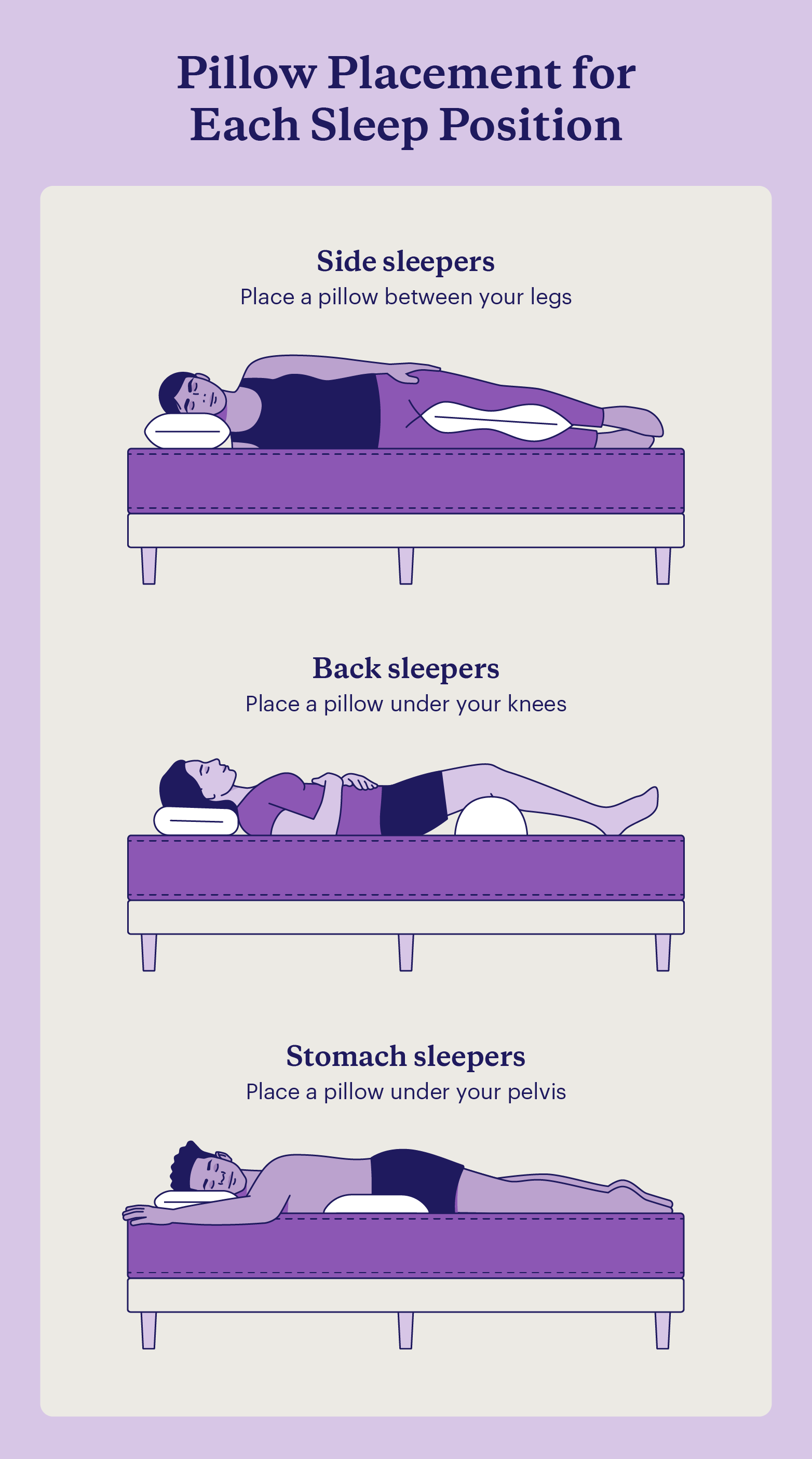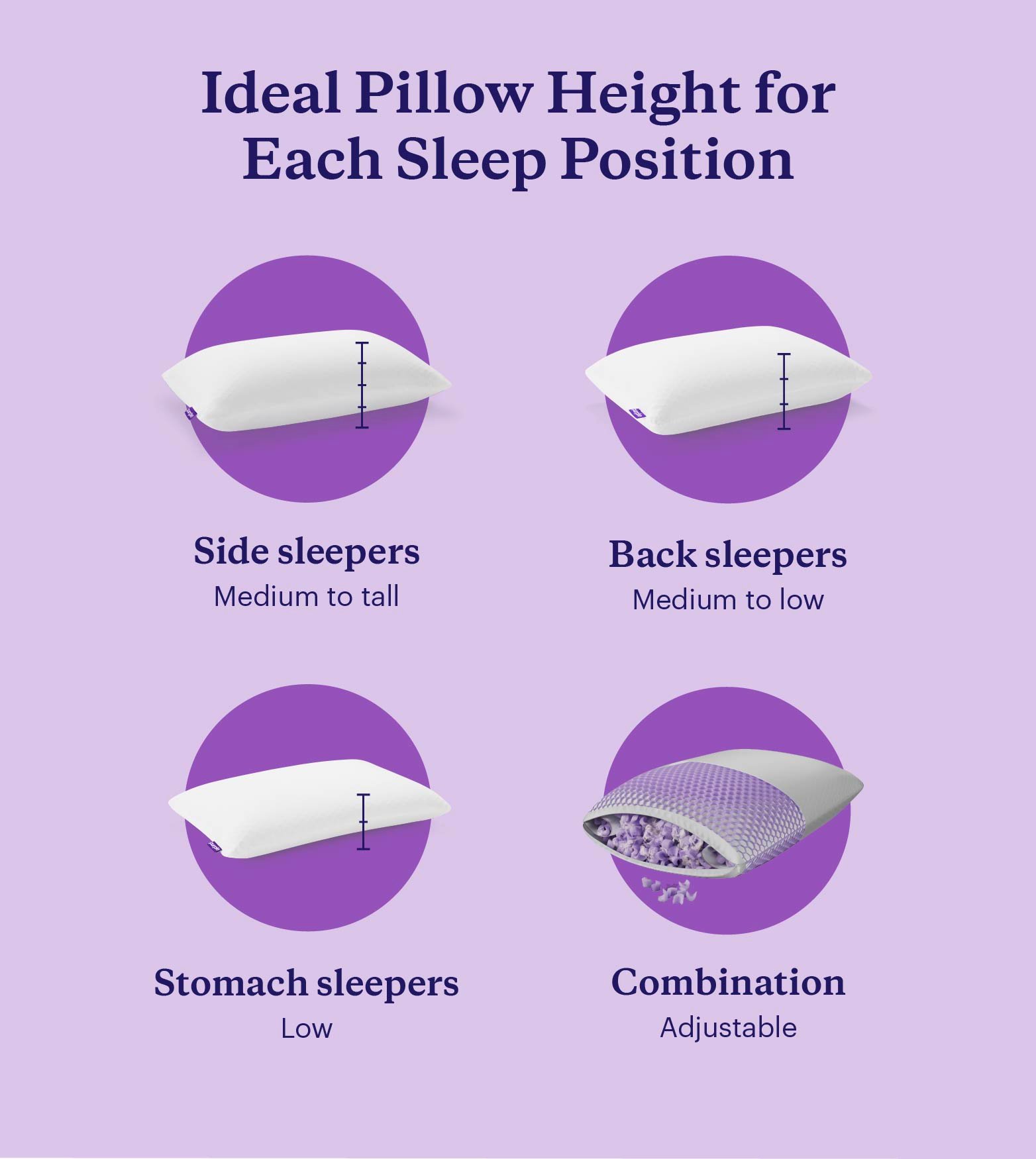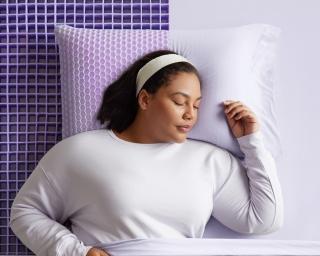How To Sleep on a Pillow Properly: Tips by Sleep Position
How To Properly Sleep on a Pillow
The correct way to sleep on a pillow is to have just enough elevation to keep your spine neutral. This will keep your neck properly aligned with the rest of your body and reduce pressure as you sleep, preventing you from waking up with neck and shoulder pain.1
If you tend to wake up with neck or shoulder pain, the issue may be your pillow or the way you are sleeping on it. Sleeping on the wrong pillow type or sleeping on a pillow the wrong way can leave you feeling tired in the morning.
The answer to how to sleep on a pillow depends on your sleeping position, since the best placement of your pillow for neutral spinal alignment depends on how you sleep.
Read along to learn how to best sleep on a pillow according to your sleep position and other pillow placement tips.
Side Sleepers
A side sleeper often prefers their left or right side instead of sleeping on their back or stomach for most of the night. There are a few variations of this position, and proper support is crucial to making sure you don’t wake up with neck pain or shoulder pain from sleeping on your side.
Here are some general pillow recommendations for this sleep position, but keep in mind that what works best for you comes down to personal preference.
- Best pillow: The best pillow for side sleepers is a medium to tall pillow or a body pillow for total body alignment. We recommend the following:
- Pillow placement: If you sleep on your side, your pillow should be high enough to cushion the space between your head and neck. Filling this gap will help maintain your spine’s natural curvature, reducing pressure on your head and neck2.
- Tip: Side sleepers may want to sleep with a second pillow between their legs, as this extra cushioning can keep your knees properly stacked on top of each other. This will keep your hips and spine properly aligned, reducing pressure and the risk of body pain while sleeping3.
Back Sleepers
Sleeping on your back is most recommended by sleep experts since it’s the easiest way to keep your spine in a neutral position. However, it’s still important to make sure your head and neck are elevated properly to prevent a stiff neck.
These pillow suggestions typically work well for back sleepers, but remember the choice ultimately depends on your personal preference.
- Best pillow: A medium to low height pillow is going to be the best pillow for back sleepers. The following are ideal options:
- Pillow placement: Placing your head on a sufficiently lofty pillow can keep your head, neck, and shoulders properly aligned. Ideally, your head shouldn’t sink too deeply into your pillow, as this may increase your discomfort and risk of developing sleep apnea4.
- Tip: Back sleepers may want to try sleeping with an extra pillow under their knees for better spinal alignment.
Stomach Sleepers
While sleeping on your stomach isn’t generally recommended, there are ways to minimize negative effects — starting with your pillow. As with back and side sleepers, the best pillow choice for stomach sleepers depends on individual preference.
- Best pillow: Pillows with low heights are the best option for stomach sleepers. We suggest these options:
- Pillow placement: Too much pillow fullness and height can raise your head to an uncomfortable angle, forcing you to strain your neck while sleeping.
- Tip: People who sleep on their stomachs should consider adding an extra pillow under their pelvis or abdomen. This helps your back stay in a neutral position while you rest on your stomach, reducing stress on your spine.5
It's also important to pair your pillow with a supportive mattress for stomach sleepers to promote spinal alignment.
Combination Sleepers
If you find yourself moving around throughout the night, you need a pillow that can adapt to those changing needs. Ultimately the best pillow for you depends on your unique needs, but here’s what generally works best for combination sleepers.
- Best pillow: The best pillow for combination sleepers is made with flexible materials that will adapt to their changing positions. Here are our recommendations:
- Purple Freeform™ Pillow: This is the most customizable option, as you can mold and shape the adjustable pillow to your preferred shape and height.
- Purple DreamLayer™ Pillow: This pillow can be adjusted to a high, medium, or low height.
- Purple TwinCloud™ Pillow: This adjustable pillow has firm and soft sides, making it easy to switch up your feel at a moment's notice.
- Pillow placement: Because combination sleepers are prone to tossing and turning throughout the night, an adjustable pillow can offer the right middle ground for providing support to their changing head and neck placements as they sleep.
- Tip: Combo sleepers who prefer back and side sleeping positions may want to opt for a medium to tall pillow, while those who find themselves sleeping on their stomachs may want a medium to low pillow. Evaluate which positions you most commonly find yourself in throughout the night and adjust accordingly.
Sleeping With a Pillow Between Legs: Benefits & Best Practices
When lying on your side, placing a pillow between your legs helps maintain proper spinal alignment by preventing the upper leg from pulling the spine out of position. It reduces stress on the lower back, hips, and knees for a more comfortable and supportive sleeping position.
A few other benefits include:
- Joint support: The pillow provides support to the knees and ankles, reducing pressure on the joints. This can be particularly helpful for those with arthritis or joint pain.
- Pain relief: By reducing nerve compression, sleeping with a pillow between your knees can contribute to pain relief, especially for conditions like sciatica6.
- Improved circulation: Proper leg and spinal alignment can enhance blood circulation, reducing the likelihood of numbness or tingling in the legs.
- Prevention of knee-on-knee contact: Avoiding direct contact between the knees prevents irritation and rubbing, particularly for those who experience discomfort due to skin-on-skin contact.
To make the most out of sleeping with a pillow between your legs, choose a pillow size and feel that provides adequate support. One great option is the Purple Harmony™ Anywhere Pillow. It’s small enough to tuck between your knees while also having the right amount of bounce and support.
Additionally, ensure the pillow is placed between your knees and thighs rather than directly under your knees for optimal alignment.
How To Use a Pillow for Pain Relief
The strategic use of a pillow can transform your quality of sleep and alleviate pain. Here are various ways to place pillows depending on your type of pain.
Pillow Placement for Back Pain
Curious about how to position a pillow for lower back pain? To start, it’s best to sleep on your back if you have back pain. If you still find this uncomfortable, try a medium to low loft pillow under your head and a pillow under your knees.
For side sleepers, a medium to tall pillow under your head as well as a pillow in between your knees can help relieve back pain. For additional support, try placing a rolled-up towel under your waist7.
Stomach sleeping is the least conducive position to ease back pain. But if this is the only way you can sleep, try placing a pillow under your pelvis to help align your spine and relieve pressure.
Pillow Placement for Neck Pain
When it comes to sleeping with neck pain, it’s less about how to position your pillow for neck pain and more about ensuring you have the right pillow loft for adequate support. The correct pillow height for you will keep your neck parallel to the mattress, not sinking downward or angled upward.
Additionally, a pillow with extra neck support is recommended8. The Purple Freeform™ Pillow has specially designed Neck Roll Chambers to offer custom, targeted support just for this purpose.
Pillow Placement for Pregnancy
To sleep better when pregnant, many people find using a body pillow can offer additional support to their hips and legs. Sleeping on your side is recommended to enhance circulation and facilitate oxygen delivery to the baby. Using a body pillow can help natural back or stomach sleepers from unintentionally rolling onto your stomach or back throughout the night.
Sleep Better With Purple Pillows
The way you sleep on your pillow can greatly impact the quality of your sleep and your overall health. By following these simple tips, you’ll know how to lay on a pillow to get the most support out of your pillow and maintain good sleep posture9.
Remember to choose the right pillow height and firmness for your sleeper type. You may even want to add extra pillows for added support to your spine at night. Regardless of your sleeping position, Purple has the ideal pillow for you.
Don’t believe us? Consider the features and benefits to compare every Purple pillow and find one that meets your needs.
FAQ
The proper pillow placement depends on your sleeping position. Apart from having a pillow for your head to rest on, if you’re a back sleeper, try placing an extra pillow underneath your knees to keep your spine properly aligned.
A side sleeper may want to sleep with an extra pillow between the knees for good sleep posture. A stomach sleeper’s head pillow needs to be very flat to prevent head and neck pain, but an extra flat pillow placed under the abdomen or pelvis may also feel comfortable.
Your pillow should be positioned between your head and neck. For better spinal alignment, stomach sleepers may benefit from an additional pillow positioned beneath their pelvis, side sleepers should consider a pillow between their knees, and back sleepers should try a pillow under their knees.
Your head and neck should be centered on your pillow, but never your shoulders. The goal is to keep your neck straight and in line with your spine, avoiding any tilting upward or downward.
Yes, your neck is supposed to rest on your pillow in a position parallel to your mattress, regardless of your sleeping position. A supportive, sufficiently high pillow will keep your neck from being bent upward or downward during sleep.
No, your pillow should not be under your shoulders. While you may prefer to sleep with your shoulders on top of your pillow, this keeps you from maintaining your spine’s neutral alignment. Studies have found that this poor sleep posture can increase spinal pain, causing body aches when you wake up10.
No, sleeping with a pillow under your back isn’t recommended, as it can negatively affect your spinal alignment. Back sleepers with lower back pain may find this pillow placement comfortable, but it’s better to sleep with a pillow under your knees for optimal alignment.
It’s good to sleep with a pillow between your legs if you’re a side sleeper. A pillow between your legs will prevent your hips from twisting while you sleep on your side.
It will also keep your knees comfortably stacked on top of each other. This prevents awkward spinal misalignment, reducing your hip and back pain at night.
This depends on your sleeping position. Sleeping without a pillow may improve posture for stomach sleepers. A pillow that is too thick can cause a stomach sleeper’s neck to arch too far backward. Sleeping with a pillow is generally recommended regardless of your sleep position.
More To Explore
Level up your sleep routine with our most-loved products.














